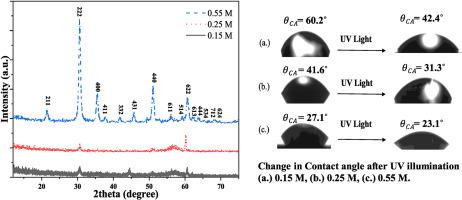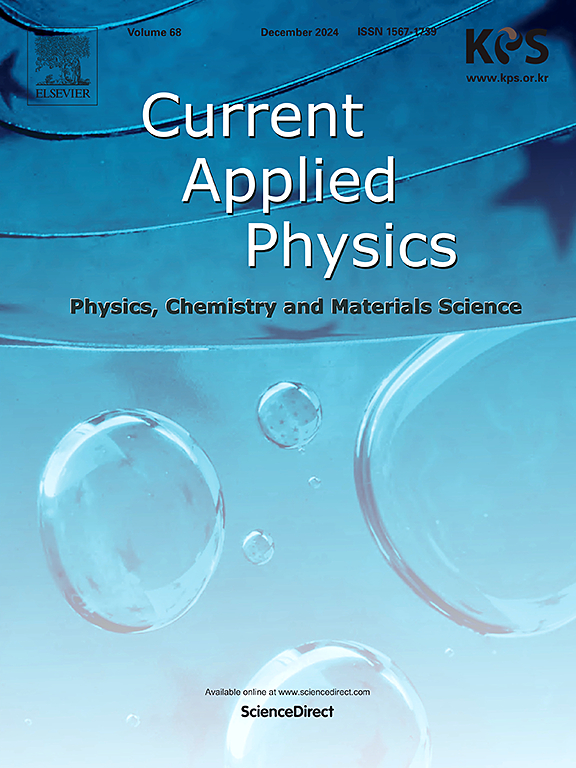Self-cleaning properties of sol-gel spin-coated In2O3 thin films with varying molarity
IF 3.1
4区 物理与天体物理
Q3 MATERIALS SCIENCE, MULTIDISCIPLINARY
引用次数: 0
Abstract
Indium oxide (In2O3) thin films were synthesized using the sol-gel spin-coating method with precursor concentrations of 0.15 M, 0.25 M, and 0.55 M, tailored for self-cleaning applications. The UV–Vis absorption spectra showed a strong absorption edge around 300 nm, with absorption intensity increasing from 0.15 M to 0.25 M and then slightly decreasing at 0.55 M. This indicates that 0.25 M film offers better light absorption. Wettability analysis revealed a decrease in water contact angle with increasing molarity: 60.2°, 41.6°and 27.1° for 0.15 M, 0.25 M and 0.55 M, respectively. Upon UV illumination, the contact angle further decreased to 42.2°, 31.3°and 23.1° confirming photo-induced hydrophilicity. This trend suggests that higher molarity films promote better water spreading, which is beneficial for self-cleaning applications. These characteristics establish In2O3 thin films as promising materials for water-based self-cleaning applications, demonstrating their potential in environmental remediation and surface maintenance technologies.

不同摩尔浓度的溶胶-凝胶自旋涂覆In2O3薄膜的自清洁性能
采用溶胶-凝胶旋涂法制备了适合自清洁应用的前驱体浓度分别为0.15 M、0.25 M和0.55 M的氧化铟(In2O3)薄膜。紫外可见吸收光谱在300 nm附近有较强的吸收边,从0.15 M到0.25 M吸收强度增大,在0.55 M吸收强度略有下降,说明0.25 M膜具有较好的光吸收能力。润湿性分析表明,随着摩尔浓度的增加,水接触角减小,0.15 M、0.25 M和0.55 M时,接触角分别为60.2°、41.6°和27.1°。在紫外光照射下,接触角进一步减小到42.2°、31.3°和23.1°,证实了光致亲水性。这一趋势表明,高摩尔浓度的薄膜促进了更好的水扩散,这有利于自清洁应用。这些特性使In2O3薄膜成为水基自清洁应用的有前途的材料,展示了它们在环境修复和表面维护技术方面的潜力。
本文章由计算机程序翻译,如有差异,请以英文原文为准。
求助全文
约1分钟内获得全文
求助全文
来源期刊

Current Applied Physics
物理-材料科学:综合
CiteScore
4.80
自引率
0.00%
发文量
213
审稿时长
33 days
期刊介绍:
Current Applied Physics (Curr. Appl. Phys.) is a monthly published international journal covering all the fields of applied science investigating the physics of the advanced materials for future applications.
Other areas covered: Experimental and theoretical aspects of advanced materials and devices dealing with synthesis or structural chemistry, physical and electronic properties, photonics, engineering applications, and uniquely pertinent measurement or analytical techniques.
Current Applied Physics, published since 2001, covers physics, chemistry and materials science, including bio-materials, with their engineering aspects. It is a truly interdisciplinary journal opening a forum for scientists of all related fields, a unique point of the journal discriminating it from other worldwide and/or Pacific Rim applied physics journals.
Regular research papers, letters and review articles with contents meeting the scope of the journal will be considered for publication after peer review.
The Journal is owned by the Korean Physical Society.
 求助内容:
求助内容: 应助结果提醒方式:
应助结果提醒方式:


